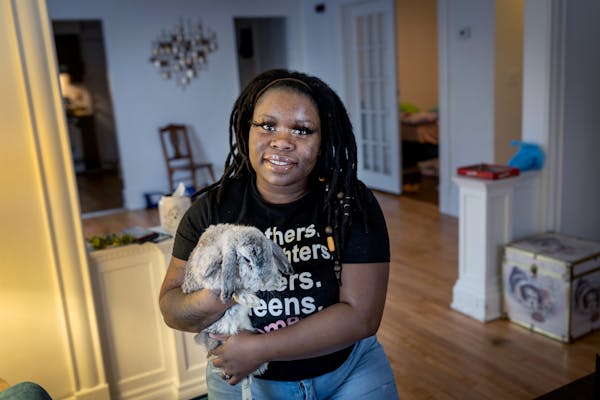Every day, De'sean Davis takes a break from his second-grade class at Nellie Stone Johnson Elementary to spend 15 minutes burning off some extra energy, running around or playing catch in the school's "sensory room."
The break room and its leader, known to students as Ms. Erin, are part of a solution that has dramatically reduced the number of behavior issues at the north Minneapolis elementary.
By this time last school year, Principal Kelly Wright had tracked more than 200 calls and referrals to the behavior support team. This school year, that number is down to 50.
"I can't tell you how many calls we would get last year about students just needing breaks," Wright said. "A lot of the time, it was for the same kids, and most of them just needed to tap out for a bit so they could refocus."
The frequency of those calls was redirecting support staff, meaning they weren't always available if a larger behavior issue erupted.
So Wright took a more proactive approach this year.
She hired Erin Crosby, an educational support professional, to provide classroom breaks to the students who needed them. Then she looked at the data from last year, scanning for patterns. Together with school staff, she determined which students were struggling to stay on task and what time of day — sometimes right after lunch or recess — when they often acted out.
Crosby meets with those students for sessions in the sensory room, usually just five to 15 minutes at a time. And she's on call if a teacher needs her to offer a break to any other students throughout the day.
"It's like they decompress when they come here," Crosby said from the sensory room, which offers an array of activities, including a trampoline and a tunnel to crawl through. "They can come here and play or just sit and talk. Then they go back to class, and then they're good for the day."
Crosby said she frequently hears from teachers who thank her, saying some variation of, "Whatever you're doing is working." But to her, she said, sometimes her work just feels like being a friend to students who need a bit of extra support.
Wright said many of Nellie Stone Johnson's students need that added attention from a trusted adult.
"We have a lot of kids with severe trauma," she said. "There was an uptick in that after COVID, and many of our students are in ongoing crisis situations."
About 45 of the school's 310 students are homeless and highly mobile. The on-site counselor's caseload is full, and the waiting list is long.
"It's a dance trying to get them everything they need," Wright said. "But we do our best trying to provide the social and emotional and mental health support they need and give them the strategies to be successful in class."
Crosby often finds casual ways to check in with her students during their break time.
In between rapid-fire games of catch with De'sean, for example, she asked how his day was going and got him talking about his career goals.
She did the same on a recent morning with fifth-grader Andrea Craig, who was busy crawling in and out of the tunnel in the center of the room. They talked about cosmetology school and mapped out a plan to get Craig a nail kit to practice manicures.
"I like talking to my break teacher," Andrea said, after Crosby encouraged her to slow her breathing and get ready to go back to class. "She talks to me about why I might be having a bad day and we fix the problem together. I love her like a sister."
There's been just one unforeseen problem with the success of the sensory room, Wright said: It's so popular that more students are asking to "take a break" with Crosby.
But that's also a sign that Wright's plan has worked even better than she'd imagined.
"Before, when the behavior team had to be called, needing a break seemed like a bad thing," she said. "Now, it's not thought of as discipline. It's just something students know they need to be successful in class."

Wolves vs. Nuggets series updates: Times for first four games set
Medical examiner identifies pedestrian hit by vehicle and killed in Bloomington
Souhan: A sausage? A knee surgery? Minnesota sports has gone mad


